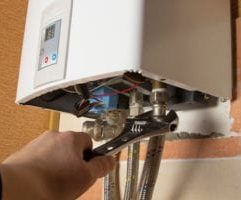
When the water comes out of the faucet hot, it’s easy to take your water heater for granted. But one cold shower can provide a stark reminder of the importance of this appliance in your everyday life.
A typical water heater will last between eight and 15 years before it needs to be replaced. Over the course of that lifespan, various maintenance needs and equipment malfunctions may disrupt the steady flow of warm water into your home. When problems arise, one of the common remedies is to (flush the water heater) and see if a reset of the appliance solves the problem.
Sometimes the water heater starts working again like new, and other times the drain and flush fails to make a difference. Either way, it’s helpful for homeowners to know (how to flush a water heater) so that they can troubleshoot the appliance before calling in a professional.
Read on to discover the common problems that can develop in water heaters, and to find out (how to flush a hot water heater).
Why Would You Need to Flush a Hot Water Heater?
Flushing a water heater provides a basic reset of the appliance’s heating process—and can help clean out buildup that may be affecting its performance. Typically, a water heater may need to be flushed due to the following reasons:
- To remove sediment buildup from inside the water heater. This is the most common reason to flush out a water heater.
- To eliminate mineral scale buildup. This buildup can accumulate faster if your water heater is fed by a hard water source.
- To improve heating speed. A clean water heater will heat up water faster—which also reduces energy consumption and saves money on your utilities bills.
- To ensure the appliance warranty remains valid. Some water heaters come with a warranty that is invalidated if the homeowner does not maintain regular flushing and cleaning of the appliance.
To benefit from regular maintenance, experts suggest flushing out your water heater every six to 12 months. This will remove sediment on a regular schedule, before it accumulates and causes additional problems in your home.
How to Drain a Water Heater
Before you can flush out the water heater, you need to turn off the appliance and drain the existing water from the tank. Start this process by shutting off the gas supply on a gas water heater, or flipping the power switch on an electric heater.
Once the appliance is off, connect a garden hose to the drain valve and run the hose to a drain in the floor or your home. Open up the drain valve, then remove the hot water pipe at the top of the water heater to ventilate the tank, which will allow it to drain faster. Allow the water heater to fully drain before you begin flushing.
How Do You Flush a Water Heater?
Once the water has been emptied out, the process of (how to flush out a water heater) is quick and easy. With the drain hose still attached, turn on the water and allow it to run for a minute before turning it off. Allow the water to fully drain out of the water tank, then repeat this process again. You should do this several times to flush out the sediment that has accumulated in the water heater. If you suspect significant buildup, or you haven’t flushed out your water heater for more than a year, continue this process until the drainage coming out of your garden hose appears to be clean.
Once you’ve finished flushing the water heater, close the drain valve and remove the garden hose. Replace the hot water pipe and seal it shut, then turn on the water to allow the tank to refill. Once the tank has filled, restore heat to the appliance by flipping the power switch on an electric water heater, or by lighting the pilot light on a gas heater.
Keep in mind that it could take an hour or longer before the water heater is able to fully heat its tank. Make a plan to forego showers or other hot water needs until the heating process is complete.
After this heating period is finished, check the heat of your water by running one of your hot water faucets. If hot water has returned, the water heater is back to normal. If the water is lukewarm or cold, there may be another problem with your water heater that the flushing was unable to address.
Still Having Problems After You Flush a Water Heater Tank?
While flushing a water heater should fix a lot of problems that may have developed in the appliance, it’s possible that a full drain and flush won’t solve whatever is wrong with your water heater. If this is the case, contact an indoor plumbing specialist to have the water heater thoroughly inspected. This professional can then repair the water heater or recommend a replacement if it’s time to purchase a new one.
By knowing the basic maintenance requirements for your water heater, you can troubleshoot simple problems and save yourself a visit from an expert. Just make sure you know your limits when it comes to DIY repair: when in doubt, call in an expert with the experience you need to solve your water heating problem.


